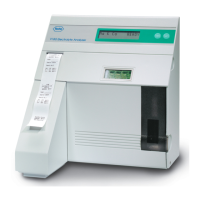Roche Diagnostics
Instructions for Use · Version 10.0 53
9180 Electrolyte Analyzer 4 Theoretical foundation
Principles of operation
Principles of operation
Measurement principle
The 9180 Electrolyte Analyzer uses the ion selective electrode (ISE) measurement
principle to precisely determine electrolyte values.
An ion-selective membrane undergoes a specific reaction with the type of electrolyte
contained in the sample. The membrane is an ion exchanger, which reacts to the
electrical change of the ion. This causes a change in the membrane potential, or
measuring voltage, which builds up in the film between the sample and the
membrane.
A galvanic measuring chain within the electrode determines the difference between
the two potential values on either side of the membrane.
The galvanic chain is closed on one side by the reference electrode, the reference
electrolyte and the “open terminal”. The membrane, inner electrolyte and inner
electrode close the other side of the reference electrode.
u Measurement principle (p. 53)
The different ion concentrations between the inner electrolyte and the sample cause
an electro-chemical potential to form on the membrane of the active electrode. The
potential is conducted by the inner electrode to the input of an amplifier. The
reference electrode is connected to ground as well as the second input of the
amplifier.
Since the reference electrode is grounded, amplification of the electrode potential
allows for further signal processing.
The ion concentration in a sample is determined using calibration curves. For a two-
point calibration, calibration curves are created using measurements of 2 standard
solutions with known ion concentrations. For a one-point calibration, these curves
are created from the measured voltage of the sample and a measurement from the
Standard A solution in the SnapPak.
Approximately 50% of the total calcium circulates as free calcium ions (Ca
2+
), also
described as ionized calcium, and is physiologically active. The
9180 Electrolyte Analyzer measures the ionized (free) calcium.

